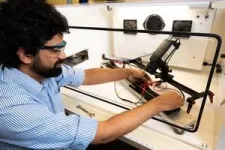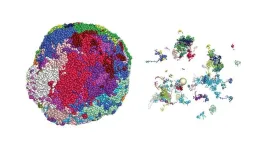(Press-News.org) RICHLAND, Wash.—A common carbon compound is enabling remarkable performance enhancements when mixed in just the right proportion with copper to make electrical wires. It’s a phenomenon that defies conventional wisdom about how metals conduct electricity. The findings, reported December 2023 in the journal Materials & Design, could lead to more efficient electricity distribution to homes and businesses, as well as more efficient motors to power electric vehicles and industrial equipment. The team has applied for a patent for the work, which was supported by the Department of Energy (DOE) Advanced Materials and Manufacturing Technologies Office.
Materials scientist Keerti Kappagantula and her colleagues at DOE’s Pacific Northwest National Laboratory discovered that graphene, single layers of the same graphite found in pencils, can enhance an important property of metals called the temperature coefficient of resistance. This property explains why metal wires get hot when electric current runs through them. Researchers want to reduce this resistance while enhancing a metal’s ability to conduct electricity. For several years they have been asking whether metal conductivity be increased, especially at high temperatures, by adding other materials to it. And if yes, can these composites be viable at commercial scale?
Now, they’ve demonstrated they can do just that, using a PNNL-patented advanced manufacturing platform called ShAPE™. When the research team added 18 parts per million of graphene to electrical-grade copper, the temperature coefficient of resistance decreased by 11 percent without decreasing electrical conductivity at room temperature. This is relevant for the manufacturing of electric vehicle motors, where an 11 percent increase in electrical conductivity of copper wire winding translates into 1 percent gain in motor efficiency.
“This discovery runs counter to what’s generally known about the behavior of metals as conductors,” said Kappagantula. “Typically, introducing additives into a metal increases its temperature coefficient of resistance, meaning they heat up faster at the same current levels compared to pure metals. We are describing a new and exciting property of this metal composite where we observe enhanced conductivity in a manufactured copper wire.”
Microstructure is key to graphene enhancement
Previously, the research team performed detailed structural and physics-based computational studies to explain the phenomenon of enhancing the electrical conductivity of metals using graphene.
In this study, they showed that the solid-phase processing used to extrude the composite wire leads to a uniform, near pore-free microstructure punctuated with tiny flakes and clusters of graphene that may be responsible for decreasing coefficient of resistance of the composite.
“We showed that flakes and clusters must both be present to make better conductors for high-temperature operations,” Kappagantula said.
Co-authors Bharat Gwalani, Xiao Li, and Aditya Nittala took advantage of a PNNL-designed testbed that measures electrical properties with high precision and accuracy to validate the improved conductivity, as reflected in the team’s detailed experimental analysis. Li and Md. Reza-E-Rabby developed the tooling and process envelopes for the solid-phase friction extrusion process that led to the patent.
Toward more efficient copper motors and wiring for urban buildings
When applied to any industrial application, the new copper-graphene composite wires will provide great design flexibility, according to the research team.
“Anywhere there's electricity, we have a use case,” Kappagantula said.
For example, coiled copper wire forms are used in the core of electric motors and generators. Motors today are designed to operate within a limited temperature range because when they get too hot, the electrical conductivity drops dramatically. With the new copper-graphene composite, motors could potentially be operated at higher temperatures without losing conductivity.
Likewise, the wiring that brings electricity from transmission lines into homes and businesses is typically made of copper. As the population density of cities increases, demand for power follows suit. A composite wire that is more conductive could potentially help meet that demand with efficiency savings.
“This technology is a beautiful solution for copper wiring in high-density urban settings,” Kappagantula added.
The research team continues its work to customize the copper-graphene material and measure other essential properties, such as strength, fatigue, corrosion, and wear resistance—all of which are crucial to qualify such materials for industrial applications. For these experiments, the research team is manufacturing wires that are about the thickness of a US penny (1.5 millimeters).
Other PNNL contributors to this research include Woongjo Choi, Julian Escobar Atehortua, Arun Bhattacharjee, Mayur Pole, Joshua Silverstein and Miao Song. This research was supported by the DOE Office of Energy Efficiency and Renewable Energy, Advanced Materials and Manufacturing Technologies Office, and the Conductivity-enhanced Materials for Affordable, Breakthrough Leapfrog Electric and Thermal Applications (CABLE) initiative, which supports US manufacturers seeking to upgrade the materials and applications that support grid reliability and other electric and thermal energy systems.
END
An electrifying improvement in copper conductivity
Adding a small amount of solid carbon to copper boosts its ability to conduct electricity—industry applications abound
2023-12-20
ELSE PRESS RELEASES FROM THIS DATE:
Finding new ways to adapt to a growing weather threat
2023-12-20
As climate change drives more frequent and intense weather, finding new ways to adapt can be a matter of life or death. A new Stanford-led study reveals a steady increase in the number of people at risk from tropical cyclones and the number of days per year these potentially catastrophic storms threaten health and livelihoods. The findings could help relief agencies, development banks, and other organizations plan more effective strategies for mitigating extreme weather impacts.
“Understanding the demographics of populations exposed to cyclones is crucial for understanding evolving risks,” said study lead author Renzhi Jing, a postdoctoral ...
Physicians at the University Hospital Bonn investigated the effect of preoperative midazolam in older patients for the first time in a large randomized study
2023-12-20
Bonn, December 20, 2023 - Prof. Mark Coburn and PD Dr. Ana Kowark from the Department of Anesthesiology and Operative Intensive Care Medicine at the University Hospital Bonn (UKB) have conducted the largest randomized study to date on the effect of preoperative, orally administered midazolam in older patients. Placebo-controlled, the physicians revealed that midazolam does not impair patient satisfaction and safety when used in low doses. The results were published today in the renowned journal JAMA Surgery.
Midazolam is a sedative from the benzodiazepine group. It is sometimes used in anesthesia to calm patients before an operation. "Despite ...
Cells of the future: A key to reprogramming cell identities
2023-12-20
The intricate process of duplicating genetic information, referred to as DNA replication, lies at the heart of the transmission of life from one cell to another and from one organism to the next. This happens by not just simply copying the genetic information; a well-orchestrated sequence of molecular events has to happen at the right time. Scientists around Prof. Maria-Elena Torres-Padilla from Helmholtz Munich have recently uncovered a fascinating aspect of this process known as "replication timing" (RT) and how special this is when life commences. The new results are now published in Nature. ...
One small material, one giant leap for life on Mars: Sussex research takes us a step closer to sustaining human life on the red planet
2023-12-20
A mineral found on the surface of Mars offers potential to create sustainable energy
Uses ‘waste’ product from recent NASA research to create transformative nanomaterials
Findings could play role in shaping sustainable habitation on the red planet – and clean energy production back home
Researchers at the University of Sussex have discovered the transformative potential of Martian nanomaterials, potentially opening the door to sustainable habitation on the red planet.
Using resources and techniques currently applied on the International Space Station and by NASA, Dr Conor Boland, a Lecturer in Materials Physics at the University of Sussex, led a ...
AIBS announces winners of 2023 Faces of Biology Photo Contest
2023-12-20
Three winners have been selected in the 2023 Faces of Biology Photo Contest, sponsored by the American Institute of Biological Sciences (AIBS) and the Society for Integrative and Comparative Biology (SICB).
“Photography is an effective tool to help communicate the process of scientific research,” said Scott Glisson, CEO of AIBS. “This contest provides a visual forum for expression, inspiration, and technical skill that can have a positive impact on how the public views research and science.
The competition showcases, in a personal way, biological research in its many forms and settings. With the images, we ...
Using AI, MIT researchers identify a new class of antibiotic candidates
2023-12-20
CAMBRIDGE, MA – Using a type of artificial intelligence known as deep learning, MIT researchers have discovered a class of compounds that can kill a drug-resistant bacterium that causes more than 10,000 deaths in the United States every year.
In a study appearing today in Nature, the researchers showed that these compounds could kill methicillin-resistant Staphylococcus aureus (MRSA) grown in a lab dish and in two mouse models of MRSA infection. The compounds also show very low toxicity against human cells, making them particularly good drug candidates.
A key innovation of the new study is that the researchers were also able to figure out ...
A trillion scents, one nose
2023-12-20
The mammalian nose is a work of evolutionary art. Its millions of nerve cells, each tailored with just one of thousands of specific odor-chemical receptors encoded in the genome, can collectively distinguish a trillion distinct scents. Those sensations, in turn, inform many behaviors, from assessing food options to discerning friends from foes to sparking memories.
Today, in the journal Nature, a research team led by scientists at Columbia’s Zuckerman Institute describes a previously undetected mechanism in mice—starring the genetic molecule RNA—that could explain how each sensory cell, or neuron, in mammalian noses becomes tailored to detect a specific ...
Innovation in development of dermatologic drugs approved by the FDA
2023-12-20
About The Study: Compared with prior decades, the number of new dermatologic drug approvals by the Food and Drug Administration (FDA) increased between 2012 and 2022. Nearly half of these drugs were considered first in class or first in indication, and several were deemed clinically useful or to have high added therapeutic benefit by health technology assessment organizations in Germany, Canada, or France.
Authors: Ravi Gupta, M.D., M.S.H.P., of the Johns Hopkins University School of Medicine ...
New brain-like transistor mimics human intelligence
2023-12-20
Taking inspiration from the human brain, researchers have developed a new synaptic transistor capable of higher-level thinking.
Designed by researchers at Northwestern University, Boston College and the Massachusetts Institute of Technology (MIT), the device simultaneously processes and stores information just like the human brain. In new experiments, the researchers demonstrated that the transistor goes beyond simple machine-learning tasks to categorize data and is capable of performing associative learning.
Although previous studies have leveraged similar strategies to develop brain-like computing devices, those transistors cannot function outside cryogenic temperatures. The new ...
Home-delivered meals and nursing home placement among people with self-reported dementia
2023-12-20
About The Study: This pilot pragmatic clinical trial included 243 homebound older adults with self- or proxy-reported dementia found a lower although nonsignificant likelihood of nursing home placement among those receiving daily-delivered meals compared with those receiving drop-shipped frozen meals. While this study was not powered to detect meaningful, statistically significant differences in nursing home placement, its feasibility and initial results warrant exploration in an adequately powered trial.
Authors: Kali S. Thomas, Ph.D., of the Brown University School of Public Health in Providence, Rhode Island, is the corresponding author.
To access the embargoed ...
LAST 30 PRESS RELEASES:
58% of patients affected by 2022 mpox outbreak report lasting physical symptoms
Golden Gate method enables rapid, fully-synthetic engineering of therapeutically relevant bacteriophages
Polar weather on Jupiter and Saturn hints at the planets’ interior details
Socio-environmental movements: key global guardians of biodiversity amid rising violence
Global warming and CO2 emissions 56 million years ago resulted in massive forest fires and soil erosion
Hidden order in quantum chaos: the pseudogap
Exploring why adapting to the environment is more difficult as people age
Society for Laboratory Automation and Screening welcomes new scientific director: Madeline M. Farley, Ph.D.
Austrian cow shows first case of flexible, multi-purpose tool use in cattle
Human nasal passages defend against the common cold and help determine how sick we get
Research alert: Spreading drug costs over the year may ease financial burden for Medicare cancer patients
Hospital partnership improves follow up scans, decreases long term risk after aortic repair
Layered hydrogen silicane for safe, lightweight, and energy-efficient hydrogen carrier
Observing positronium beam as a quantum matter wave for the first time
IEEE study investigates the effects of pointing error on quantum key distribution systems
Analyzing submerged fault structures to predict future earthquakes in Türkiye
Quantum ‘alchemy’ made feasible with excitons
‘Revoice’ device gives stroke patients their voice back
USF-led study: AI helps reveal global surge in floating algae
New method predicts asthma attacks up to five years in advance
Researchers publish first ever structural engineering manual for bamboo
National poll: Less than half of parents say swearing is never OK for kids
Decades of suffering: Long-term mental health outcomes of Kurdish chemical gas attacks
Interactional dynamics of self-assessment and advice in peer reflection on microteaching
When aging affects the young: Revealing the weight of caregiving on teenagers
Can Canada’s health systems handle increased demand during FIFA World Cup?
Autistic and non-autistic faces may “speak a different language” when expressing emotion
No clear evidence that cannabis-based medicines relieve chronic nerve pain
Pioneering second-order nonlinear vibrational nanoscopy for interfacial molecular systems beyond the diffraction limit
Bottleneck in hydrogen distribution jeopardises billions in clean energy
[Press-News.org] An electrifying improvement in copper conductivityAdding a small amount of solid carbon to copper boosts its ability to conduct electricity—industry applications abound








